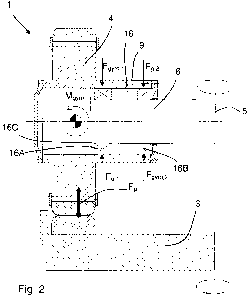Some of the information on this Web page has been provided by external sources. The Government of Canada is not responsible for the accuracy, reliability or currency of the information supplied by external sources. Users wishing to rely upon this information should consult directly with the source of the information. Content provided by external sources is not subject to official languages, privacy and accessibility requirements.
Any discrepancies in the text and image of the Claims and Abstract are due to differing posting times. Text of the Claims and Abstract are posted:
| (12) Patent Application: | (11) CA 2687153 |
|---|---|
| (54) English Title: | ROLLER MILL FOR GRINDING PARTICULATE MATERIAL |
| (54) French Title: | LAMINOIR POUR MEULAGE DE MATERIAU PARTICULAIRE |
| Status: | Deemed Abandoned and Beyond the Period of Reinstatement - Pending Response to Notice of Disregarded Communication |
| (51) International Patent Classification (IPC): |
|
|---|---|
| (72) Inventors : |
|
| (73) Owners : |
|
| (71) Applicants : |
|
| (74) Agent: | SMART & BIGGAR LP |
| (74) Associate agent: | |
| (45) Issued: | |
| (86) PCT Filing Date: | 2007-07-04 |
| (87) Open to Public Inspection: | 2009-01-08 |
| Examination requested: | 2012-06-22 |
| Availability of licence: | N/A |
| Dedicated to the Public: | N/A |
| (25) Language of filing: | English |
| Patent Cooperation Treaty (PCT): | Yes |
|---|---|
| (86) PCT Filing Number: | PCT/EP2007/056769 |
| (87) International Publication Number: | WO 2009003527 |
| (85) National Entry: | 2009-11-12 |
| (30) Application Priority Data: | None |
|---|
A roller mill (1 ) for grinding particulate material such as cement raw materials, cement clinker, coal and similar materials, said roller mill (1 ) comprising a substantially horizontal grinding table (3) and a set of rollers revolving about a vertical shaft (5); said set of rollers comprising a number of rollers (4) rotatable about respective roller axes and being connected via a roller bearing (16) and a roller shaft (6) to the vertical shaft (5), and said set of rollers (4) being configured for interactive operation with the grinding table (3) for application of pressure to the particulate material; characterized in that each roller bearing (16) across its entire axial extent is axially located radially towards the vertical shaft (5) inwardly of the location of the resulting force from the grinding zone imposed upon the respective roller, in use.
L'invention concerne un laminoir (1) pour le meulage de matériau particulaire comme des matières premières de ciment, une scorie de ciment, du charbon et des matériaux similaires, ledit laminoir (1) contenant une table de meulage sensiblement horizontale (3) et un ensemble de cylindres tournant autour d'un arbre vertical (5); ledit ensemble de cylindres comprenant un certain nombre de cylindres (4) rotatifs autour d'axes de cylindre respectifs et connectés par le biais d'un palier de roulement (16) et d'un arbre de cylindre (6) à l'arbre vertical (5), et ledit ensemble de cylindres (4) étant configuré pour interagir avec la table de meulage (3) pour appliquer une pression au matériau particulaire; chaque palier de roulement (16) sur toute son étendue axiale étant dirigé axialement et radialement vers l'arbre vertical (5) rentré vers l'intérieur de l'emplacement de la force résultante à partir de la zone meulage sur laquelle pèse le cylindre respectif, en cours d'utilisation.
Note: Claims are shown in the official language in which they were submitted.
Note: Descriptions are shown in the official language in which they were submitted.

2024-08-01:As part of the Next Generation Patents (NGP) transition, the Canadian Patents Database (CPD) now contains a more detailed Event History, which replicates the Event Log of our new back-office solution.
Please note that "Inactive:" events refers to events no longer in use in our new back-office solution.
For a clearer understanding of the status of the application/patent presented on this page, the site Disclaimer , as well as the definitions for Patent , Event History , Maintenance Fee and Payment History should be consulted.
| Description | Date |
|---|---|
| Application Not Reinstated by Deadline | 2014-07-04 |
| Time Limit for Reversal Expired | 2014-07-04 |
| Deemed Abandoned - Failure to Respond to Maintenance Fee Notice | 2013-07-04 |
| Letter Sent | 2012-07-05 |
| Request for Examination Received | 2012-06-22 |
| All Requirements for Examination Determined Compliant | 2012-06-22 |
| Request for Examination Requirements Determined Compliant | 2012-06-22 |
| Inactive: Cover page published | 2010-01-13 |
| Inactive: Notice - National entry - No RFE | 2010-01-11 |
| Application Received - PCT | 2010-01-04 |
| Inactive: First IPC assigned | 2010-01-04 |
| National Entry Requirements Determined Compliant | 2009-11-12 |
| Application Published (Open to Public Inspection) | 2009-01-08 |
| Abandonment Date | Reason | Reinstatement Date |
|---|---|---|
| 2013-07-04 |
The last payment was received on 2012-06-11
Note : If the full payment has not been received on or before the date indicated, a further fee may be required which may be one of the following
Please refer to the CIPO Patent Fees web page to see all current fee amounts.
| Fee Type | Anniversary Year | Due Date | Paid Date |
|---|---|---|---|
| Basic national fee - standard | 2009-11-12 | ||
| MF (application, 2nd anniv.) - standard | 02 | 2009-07-06 | 2009-11-12 |
| MF (application, 3rd anniv.) - standard | 03 | 2010-07-05 | 2010-06-22 |
| MF (application, 4th anniv.) - standard | 04 | 2011-07-04 | 2011-06-21 |
| MF (application, 5th anniv.) - standard | 05 | 2012-07-04 | 2012-06-11 |
| Request for examination - standard | 2012-06-22 |
Note: Records showing the ownership history in alphabetical order.
| Current Owners on Record |
|---|
| FLSMIDTH A/S |
| Past Owners on Record |
|---|
| MORTEN OLSEN |
| SOEREN HANGHOEJ |